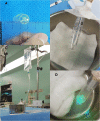How to perform the dusting technique for calcium oxalate stone phantoms during Ho:YAG laser lithotripsy
- PMID: 30424765
- PMCID: PMC6234550
- DOI: 10.1186/s12894-018-0417-5
How to perform the dusting technique for calcium oxalate stone phantoms during Ho:YAG laser lithotripsy
Abstract
Background: To determine the most efficacious setting of Holmium:yttrium-aluminum-garnet (Ho:YAG) laser with a maximum power output of 120 W with in vitro phantom-stone dusting technique.
Methods: A laser was used to treat two 4 × 3 × 3 mm3 sized phantom stones in 5 mL syringes with 1 mm-sized holes at the bottom. According to the pulse width (short 500, middle 750, long pulse 1000 μsec), maximal pulse repetition rates from 50 to 80 Hz were tested with pulse energy of 0.2, 0.4, 0.5, and 0.8 J. Six times of the mean dusting times were measured at each setting. Dusting was performed at continuous firing of the laser until the stones become dusts < 1 mm.
Results: The mean Hounsfield unit of phantom stones was 1309.0 ± 60.8. The laser with long pulse generally showed shorter dusting times than short or middle pulse width. With increasing the pulse energy to 0.5 J, the dusting time decreased. However, the pulse energy of 0.8 J showed longer dusting times than those of 0.5 J. On the post-hoc analysis, the pulse energy of 0.5 J, long pulse width, and the repetition rates of 70 Hz demonstrated significantly shorter dusting times than other settings.
Conclusions: The results suggest that long pulse width with 0.5 J and 70 Hz would be the most efficacious setting for dusting techniques of plaster stone phantoms simulating calcium oxalate stones using the 120 W Ho:YAG laser.
Keywords: Calcium oxalate; Dusting; Energy; Ho:YAG laser; Lithotripsy.
Conflict of interest statement
Ethics approval and consent to participate
This paper is not associated with research involving human subjects, human material, or human data. As such, not ethical approval was required.
Consent for publication
None.
Competing interests
The authors declare that they have no competing interests.
Publisher’s Note
Springer Nature remains neutral with regard to jurisdictional claims in published maps and institutional affiliations.
Figures



References
-
- Kumar A, Kumar N, Vasudeva P, Kumar Jha S, Kumar R, Singh H. A prospective, randomized comparison of shock wave lithotripsy, retrograde intrarenal surgery and miniperc for treatment of 1 to 2 cm radiolucent lower calyceal calculi: a single center experience. J Urol. 2015;193:160–164. doi: 10.1016/j.juro.2014.07.088. - DOI - PubMed
MeSH terms
Substances
LinkOut - more resources
Full Text Sources

